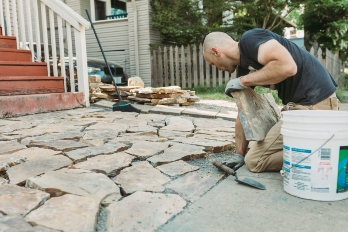Let us guess: Your dream home has Pinterest-worthy landscaping, a modern kitchen, 2.5 spacious bathrooms, gleaming wood floors, and enough room to give everyone in the family a little privacy when they want it. And, unfortunately, that’s not the one you actually own.
Welcome to the club! Homeowners are busy bees with renovating and improving these days. With home prices so high, many bought places that need work. And with too few homes to choose from, we’re remodeling instead of moving when we want more or better space.
Whatever the case for you, there’s the question of how to finance that transformation of your kitchen, bathroom, or yard. So here are eight solid ways to get your home renovation job done:
1. Cash
Consider this if you:
- Have a separate emergency fund saved
- Can save what you need before repairs become critical
If you had a pile of extra money, you probably wouldn’t be reading this post! But still, we have to say it: The best way to pay for a renovation is with cash, to keep your overall debt to a minimum. Put yourself on an automated savings schedule and take the opportunity to cultivate that virtue called patience.
Of course, patience can wear thin when core rooms like the kitchen and the bathroom are way past their prime. And waiting until you have cash isn’t always realistic — or even smart. Case in point: Don’t delay critical repairs for too long. A leaky roof would fall into this category. Neglect a problem like that, and it might turn into a bigger, more expensive one.
If you’re not sure how urgent a repair is, especially for something like the roof or anything structural, consult a professional — such as a licensed contractor or a home inspector.
Finally, don’t deplete your savings to renovate. It’s important to maintain a healthy emergency fund.
2. Grants and special programs
Consider this if you:
- Don’t want to miss out on free or cheap money
Nonprofits and government agencies at all levels offer grants or low-cost loans for home repairs, rehab, and energy upgrades. Research what’s available in your area before taking out a traditional bank loan. A local homeownership advisor can be a big help.
Whether you qualify could depend on your income and the type of house you have. But don’t assume you’re not eligible based on income. Income restrictions that do exist can vary widely.
Here are just four common types of programs:
- HIP loans. Many counties offer a “HIP,” or home improvement program. These subsidized loans can save you a lot of money, especially on interest, compared to commercial loans. There’s usually an income cap, plus a variety of rules.
- Historic preservation. If your home is in a historic district, you might be able to get in on a program that helps fund renovations. One place to start your research is PreservationDirectory.com.
- Disability assistance. Are you disabled? Many programs help with home modifications needed for medical or disability reasons (such projects are also tax-deductible). Some are devoted to disabled veterans. Try contacting your local social services.
- Energy efficiency. There are all kinds of incentives and low-cost loans for insulation, new windows, efficient heating and cooling systems, and more. Visit the DSIRE database to find programs that might apply to you.
3. Zero-percent credit card
Consider this if you:
- Need only a moderate amount of money
- Have the financial discipline to treat the card like a regular loan
Credit card debt shouldn’t be taken lightly. But if you’re financially disciplined and your project is on the small side, a 0% card deal is a fast, easy way to get an interest-free loan. As long as you do in fact pay it off promptly. Know thyself!
Before you commit, get out your magnifying glass and scrutinize the fine print for hidden fees. Then be sure to treat the sum you put on the card like a regular loan. Don’t put anything else on the card, put yourself on a payment schedule, and pay off the balance before the 0% period ends. If you don’t pay it off by the deadline, you might be charged all the interest retroactively.
Heads up: The credit inquiry required by the application can lower your FICO score for a while, and so can carrying a big credit card balance, even if it’s not overdue. If you won’t be looking for new credit in the near future, the short-term hit to your credit score probably won’t matter to you.
4. Home equity loan
Consider this if you:
- Have at least 20% equity in your home
- Need a large lump sum
Do you have equity in your home and need a large lump sum for your project? A home equity loan, also called a second mortgage, might be the way to go. Interest rates tend to be higher than for a first mortgage, but still good, and the interest may be tax-deductible.
As with a first mortgage, you have to qualify, meet the lender’s requirements, and pay various fees. The typical term is 15 years or less. The loan can be refinanced later if necessary, but you have to pay off the balance if you sell your house. Watch out for maintenance fees and penalties for early payoff.
Heads up: Keep in mind that any time you tap your home equity, you’re not only reversing the equity-building process but also putting up your home as collateral. You risk foreclosure if you fall behind on your monthly payments. That’s why many financial advisors say that the only good reason to use your equity is to make home repairs or improvements that add market value.
5. Home equity line of credit (HELOC)
Consider this if you:
- Have at least 20% equity in your home
- Don’t need more than $25,000
- Want to make a series of smaller improvements
Compared to a home equity loan, a home equity line of credit (HELOC) works more like a credit card. You don’t have to take out (and pay interest on) a big sum all at once. Instead, you borrow and pay as you go. This can make a HELOC a good choice for a modest renovation or a series of small improvements.
All that flexibility might make a HELOC sound less formal than a home equity loan, but it’s not. You still have to qualify, meet the lender’s requirements, etc. Plus, a HELOC is more complicated overall. Among other things, the interest rate is usually variable, and there might be ongoing fees.
Heads-up: See number 4. As with a home equity loan, you risk foreclosure if you fall behind on your payments.
6. HUD Title 1 loan
Consider this if you:
- Don’t have much equity or cash
- Don’t need more than $25,000
- Have a modest income
Let’s say you need renovation money, but you’re short on both cash and equity. Look into the Department of Housing and Urban Development’s Title 1 Property Improvement Loan (also known as FHA Title 1). While these loans are made by traditional lenders, they’re insured by the federal government, so they’re easier to qualify for.
The program enables fixed-rate loans of up to $25,000 (more for multifamily properties) for a wide range of home improvements, including replacement of certain appliances. You can take as long as 20 years to pay it back.
Requirements, terms, and interest rates can vary from lender to lender. Find a HUD/FHA-approved lender at HUD.gov.
Heads-up: If the loan is for more than $7,500, you have to put up your home as collateral.
7. Refinancing
Consider this if you:
- Want to do a really big, expensive renovation
- Have at least 20% equity in your home
For a really big, expensive remodel, refinancing might be the way to go. You’re likely to get the lowest possible interest rate on the money you need for the project. Plus, the interest is usually tax deductible.
You’re probably familiar with refinancing as a way to save money on your mortgage when interest rates drop. It’s also a way to extract equity from your home.
A “cash-out refi,” as it’s called, replaces your old loan with a new, larger one that pays off your mortgage, covers the new closing costs, and leaves you with some cash.
Again, remember that you’ll be spending the wealth you’ve built up in your home. You’ll have to be the judge of whether it’s worth it. Also keep in mind that if you don’t maintain 20% equity in your home, you might be forced to buy mortgage insurance. That will increase your monthly payment even more.
Heads-up: Don’t start renovating until you close on the new loan. You’re going to have to get the house appraised. If it’s all ripped up, the appraisal could come in low, and your lender won’t close on the new loan.
8. HUD 203(k) refinancing
Consider this if you:
- Have less than 20% equity in your home
- Have the stamina for red tape
If you’ve got renovating to do but don’t have enough equity for a traditional refinance, see if the Department of Housing and Urban Development can help. HUD’s “203(k)” government insurance programs make it easier to qualify for a refinance-and-rehab loan.
The Standard 203(k) covers projects ranging from modest upgrades (there’s a $5,000 minimum) to near-total reconstruction. The Limited 203(k) has no minimum and tops out at $35,000. Requirements, terms, and interest rates can vary from lender to lender. Find a HUD/FHA-approved lender at HUD.gov.
Heads-up: A downside of the 203(k) program is that applying can be pretty complicated. The Standard 203(k) requires that you hire an independent HUD-certified consultant to manage the project.




